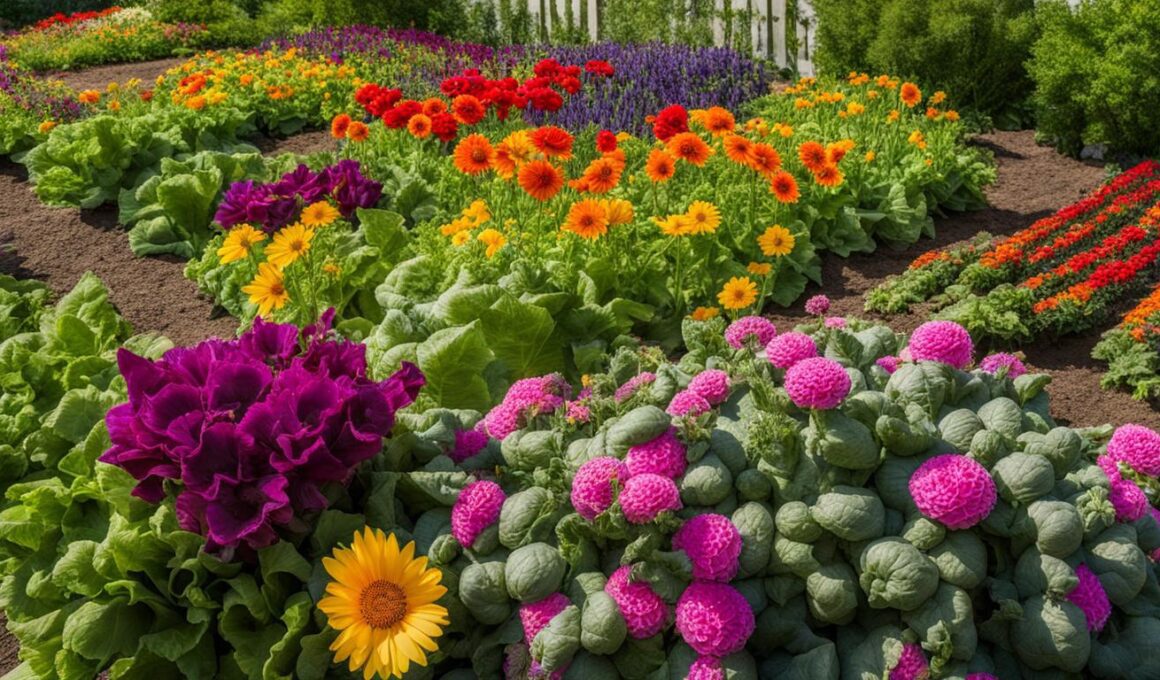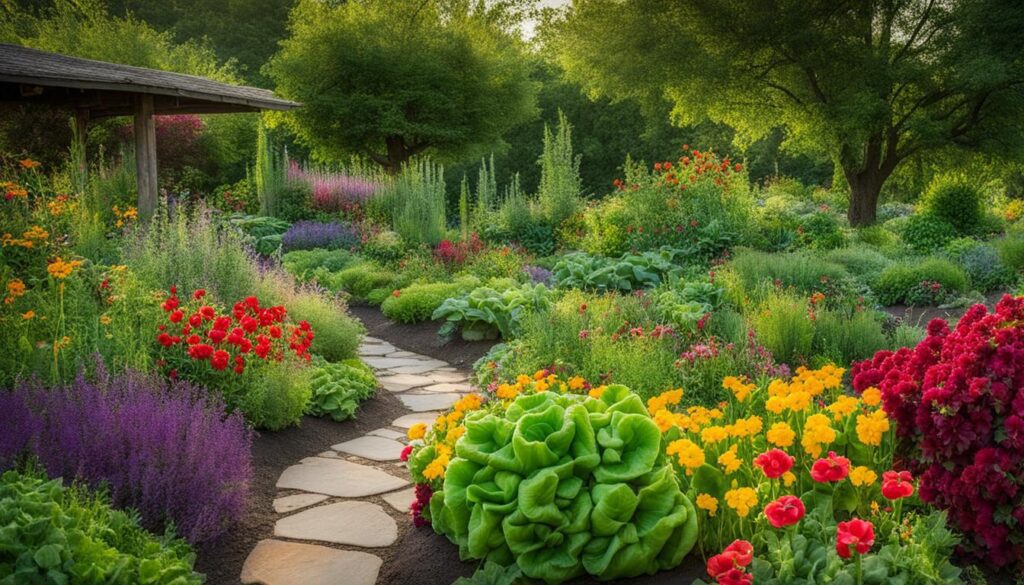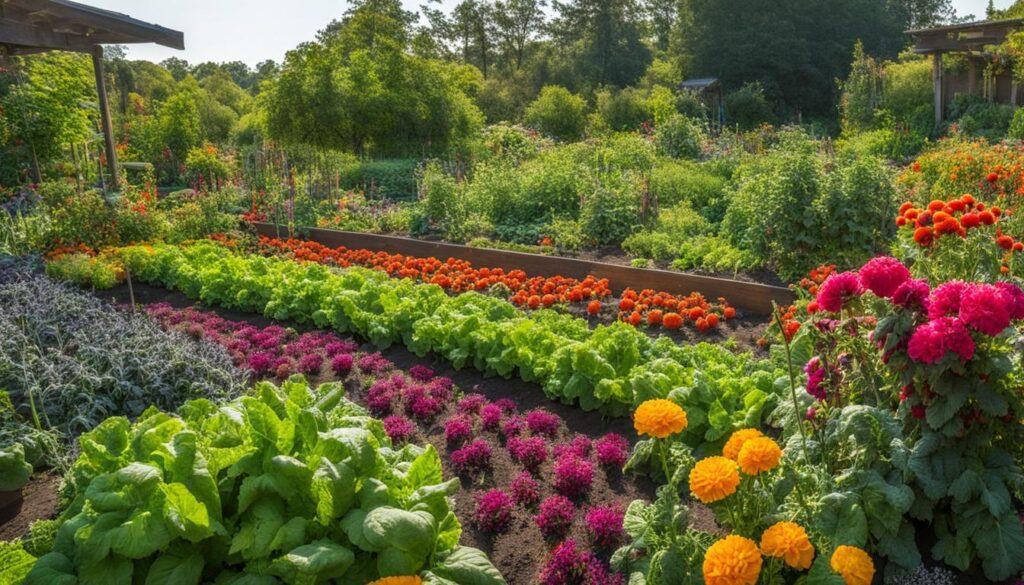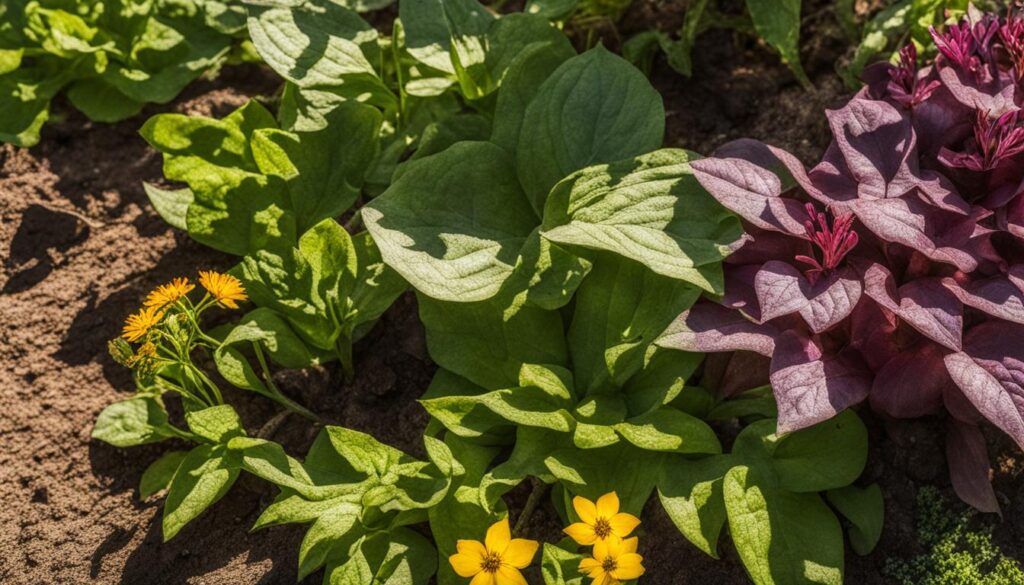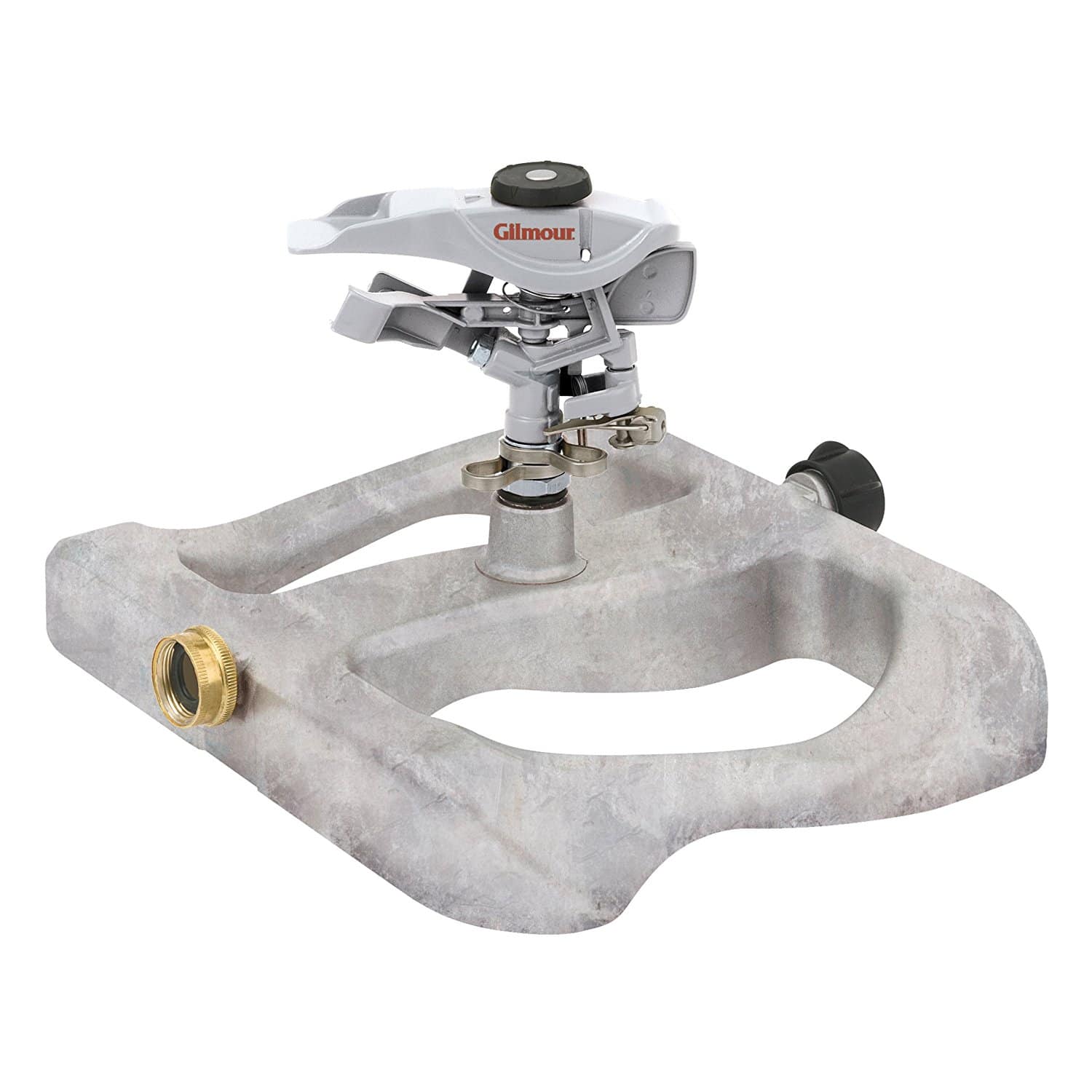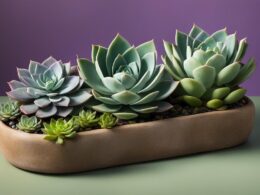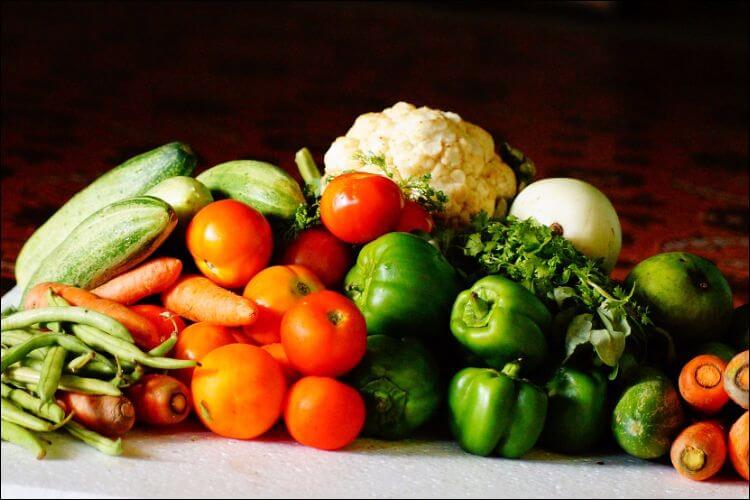Planting flowers in your vegetable garden can bring numerous benefits. Flowers attract pollinators such as bees and butterflies, which are essential for the successful pollination of vegetables. Marigolds are particularly beneficial companions to vegetables as they repel bad insects. Zinnias, dahlias, and sunflowers also attract butterflies and bees. By planting flowers in your vegetable garden, you not only enhance the aesthetics but also create a harmonious environment for both flowers and vegetables to thrive.
Key Takeaways:
- Planting flowers in your vegetable garden attracts pollinators like bees and butterflies, which promote successful pollination.
- Marigolds repel bad insects and make excellent companions for vegetables.
- Zinnias, dahlias, and sunflowers attract butterflies and bees, enhancing the biodiversity of your garden.
- Flowers contribute to the aesthetics of your vegetable garden, creating a visually appealing environment.
- Ensure the compatibility of flowers and vegetables in terms of growing requirements and compatibility before planting.
The Compatibility of Flowers and Vegetables in the Garden
Flowers and vegetables can grow in harmony in the garden, creating a beautiful and functional space. By choosing the right flowers, you can enhance the growth and productivity of your vegetables. Certain flowers have natural properties that benefit vegetables, making them great companions in the garden.
Marigolds, for example, are known to repel bad insects like aphids and nematodes. Planting marigolds near your vegetables acts as a natural pest control method, reducing the need for chemical interventions. Zinnias and dahlias, on the other hand, attract pollinators such as butterflies and bees. These pollinators play a crucial role in the successful pollination of vegetables, resulting in better yields.
To ensure compatibility between flowers and vegetables, consider their specific needs. Some flowers may require more sunlight or water than certain vegetables. Additionally, be mindful of the sizes of the flowers, as taller varieties may overshadow the vegetables. By carefully selecting flowers that benefit vegetables, you can create a diverse and thriving garden ecosystem.
To illustrate the compatibility of flowers and vegetables, take a look at the table below:
| Vegetables | Companion Flowers |
|---|---|
| Tomatoes | Marigolds, nasturtiums |
| Zucchini | Nasturtiums, calendula |
| Lettuce | Pansies, calendula |
| Cabbage | Nasturtiums, borage |
By incorporating flowers that benefit vegetables into your garden, you not only create a visually appealing space but also promote the health and productivity of your vegetable crops.
Considerations for Adding Flowers to Your Vegetable Garden
When adding flowers to your vegetable garden, there are a few key considerations to keep in mind. First, it’s important to pair cool-season flowers with cool-season vegetables and warm/hot-season flowers with warm/hot-season vegetables. This ensures that both the flowers and vegetables receive the appropriate climate conditions for optimal growth.
Another important consideration is understanding the growing requirements of the flowers you choose. Different flowers have varying sunlight and water needs, so it’s essential to place them in areas of the garden where they will receive adequate light and moisture. Failure to do so can result in poor growth or even the death of the flowers.
It’s also crucial to consider the size of the flowers when planting them in your vegetable garden. Some flowers can grow tall and overshadow the surrounding vegetables, depriving them of much-needed sunlight. To prevent this, choose flowers that have a similar height or growth habit as your vegetables, or position them in a way that allows for adequate light to reach the vegetables.
Table: Common Flower-Vegetable Combinations
| Flower | Vegetable |
|---|---|
| Marigolds | Tomatoes |
| Nasturtiums | Cucumbers |
| Calendula | Cabbage |
| Chives | Carrots |
| Borage | Strawberries |
Lastly, it’s essential to consider the compatibility of certain flowers with specific vegetables. While some flowers can benefit vegetables by repelling pests or attracting beneficial insects, others may hinder the growth of certain vegetables. Before planting flowers and vegetables together, research their compatibility or consult a gardening expert to ensure a harmonious and successful garden.
Companion Planting: Flowers and Vegetables in the Same Bed
Companion planting, the practice of growing different plants together for mutual benefits, can be a game-changer for your vegetable garden. When it comes to flowers and vegetables, companion planting offers a range of advantages. One of the key benefits is attracting beneficial insects, such as bees and ladybugs, which contribute to pollination and pest control. By planting flowers alongside your vegetables, you create a welcoming habitat for these helpful creatures.
Companion planting also enhances biodiversity in your garden, creating a more resilient ecosystem. The flowers provide additional food sources for pollinators and attract a wider variety of species. This diversity can help reduce the risk of pest outbreaks and increase overall garden health.
Furthermore, companion planting with flowers can improve the overall aesthetic appeal of your vegetable garden. The vibrant colors and delicate blooms of flowers create a visually pleasing environment that you can enjoy while harvesting your vegetables.
To make the most of companion planting, it’s important to choose the right flowers for your vegetables. Consider the bloom time, flower shape, and height when selecting companion plants. Aim for a mix of flowers that bloom at different times to provide a steady supply of nectar and pollen throughout the growing season. Additionally, select flowers that attract specific beneficial insects you want to encourage, such as dill or fennel for attracting ladybugs.
Table: Flowers for Companion Planting with Vegetables
| Flower | Companion Vegetables |
|---|---|
| Marigold | Tomatoes, peppers, cucumbers |
| Nasturtium | Squash, radishes, cucumbers |
| Borage | Tomatoes, squash, strawberries |
| Calendula | Carrots, lettuce, tomatoes |
| Lavender | Cabbage, onions, cucumbers |
| Sunflower | Pumpkins, corn, beans |
Note: This table provides a general overview of companion flowers and their compatible vegetables. There may be other suitable flower options depending on your specific garden conditions and preferences. Experimentation and observation are key to finding the best companion planting combinations for your vegetable garden.
Choosing Flower Varieties for Your Vegetable Patch
When it comes to selecting flower varieties for your vegetable garden, there are several factors to consider. You want flowers that not only enhance the aesthetics of your garden but also attract pollinators to benefit your vegetables. By choosing the right flower varieties, you can create a harmonious environment where both flowers and vegetables thrive.
To attract pollinators to your vegetable patch, opt for flowers that have a composite shape, such as zinnias, cosmos, daisies, sunflowers, and purple coneflowers. These flowers provide ample nectar and pollen, making them highly attractive to bees and other pollinators. By sprinkling these flowers throughout your garden, you give beneficial insects more opportunities to visit and pollinate your vegetables.
It’s also important to consider the bloom time of the flowers you choose. Synchronize the flowering period of your selected varieties with that of your vegetables to ensure a continuous supply of nectar and pollen. This helps to maintain a thriving pollinator population in your garden and promotes successful vegetable pollination.
| Flower Variety | Best Bloom Time | Height | Benefits |
|---|---|---|---|
| Zinnias | Summer to fall | Medium | Attracts butterflies and bees |
| Cosmos | Summer to fall | Medium | Attracts butterflies and bees |
| Daisies | Summer | Low | Attracts bees |
| Sunflowers | Summer to fall | Tall | Attracts butterflies and bees |
| Purple Coneflowers | Summer to fall | Tall | Attracts butterflies and bees |
While low-growing flowers are preferred to prevent competition with vegetables for sunlight, taller varieties can provide shade for certain crops like lettuces during the hot summer months. By strategically selecting flower varieties for your vegetable patch, you can create a balanced and productive garden that not only yields delicious vegetables but also adds beauty and diversity to your outdoor space.
Starting Simple and Incorporating Native Perennials
If you’re new to planting flowers in your vegetable garden, starting with easy-to-grow annual flowers is a great way to begin. Annual flowers are low-maintenance and produce abundant blooms throughout the season, adding color and beauty to your garden. They also provide flexibility in changing your garden design from year to year, allowing you to experiment with different flower varieties. In addition to annuals, it’s important to incorporate native perennials in your garden to attract native bees and promote a healthy ecosystem.
Native perennials are plants that are naturally found in your region and have adapted to the local conditions. They are well-suited to the climate and soil, making them easier to grow and maintain. By incorporating native perennials in your vegetable garden, you create a habitat that attracts native bees, which are important pollinators for both flowers and vegetables. Native bees are often more efficient pollinators than honeybees, and by providing them with a welcoming environment, you can enhance the pollination of your plants.
When choosing native perennials for your vegetable garden, consider selecting a variety of plants that bloom at different times throughout the growing season. This ensures a continuous supply of nectar and pollen for the native bees. Some examples of native perennials that are attractive to bees include lavender, coneflower, bee balm, and aster. Be sure to research which native perennials are suitable for your specific region and growing conditions.
Benefits of Incorporating Native Perennials in Your Vegetable Garden
There are several benefits to incorporating native perennials in your vegetable garden:
- Attracting native bees: Native perennials provide a food source for native bees, attracting them to your garden and increasing pollination.
- Promoting biodiversity: By adding native plants to your garden, you create a more diverse habitat that supports a wide range of wildlife, including beneficial insects.
- Enhancing soil health: Native perennials have deep root systems that help improve soil structure and increase nutrient availability.
- Reducing maintenance: Once established, native perennials require less maintenance than non-native plants, saving you time and effort.
By starting simple with annual flowers and incorporating native perennials, you can create a thriving and beautiful vegetable garden that not only provides you with fresh produce but also supports native pollinators and promotes a sustainable ecosystem.
Are There Benefits to Planting Flowers in a Vegetable Garden?
Planting flowers in a vegetable garden can beautify your vegetable garden and offer several benefits. Flowers attract pollinators which can improve the yield of your vegetable plants. They can also help control pests by attracting beneficial insects. Additionally, flowers can add a pop of color and visual interest to your garden.
Conclusion
Planting flowers in your vegetable garden brings a multitude of benefits. Not only do flowers enhance the aesthetics of your garden, but they also promote pollination, which is essential for the successful growth of your vegetables.
By attracting pollinators such as bees and butterflies, flowers play a crucial role in ensuring that your vegetables receive the necessary pollen for fertilization. This, in turn, leads to better yields and healthier crops.
In addition to their role in pollination, certain flowers like marigolds can repel bad insects, providing a natural form of pest control for your vegetables. This helps to protect your plants without the need for harsh chemical pesticides.
So, whether you’re looking to enhance the beauty of your garden or improve the productivity of your vegetable patch, incorporating flowers is a wise decision. Not only will you create a visually appealing space, but you’ll also promote a thriving and balanced ecosystem for both flowers and vegetables to thrive.
FAQ
Should I plant flowers in my vegetable garden?
Yes, planting flowers in your vegetable garden can bring numerous benefits. Flowers attract pollinators such as bees and butterflies, which are essential for the successful pollination of vegetables. Additionally, certain flowers, like marigolds, repel bad insects, protecting your vegetables naturally.
What is the compatibility of flowers and vegetables in the garden?
Flowers and vegetables can grow in harmony in the garden. Certain flowers, like marigolds, have natural properties that repel bad insects, making them beneficial companions to vegetables. Some flowers, like zinnias and dahlias, attract pollinators such as butterflies and bees, enhancing the pollination process for vegetables.
What should I consider when adding flowers to my vegetable garden?
When adding flowers to your vegetable garden, consider the growing requirements of the flowers, ensuring they receive adequate sunlight and water. Be mindful of the sizes of the flowers, as some may grow tall and overshadow the vegetables. Additionally, certain flowers may hinder the growth of specific vegetables, so it’s essential to double-check compatibility before planting.
What is companion planting?
Companion planting involves planting flowers and vegetables in the same bed to boost yields and maintain the health of crops. One of the key benefits of companion planting is attracting native bees and other beneficial insects that contribute to pollination. Planting flowers near vegetables not only supports pollinator populations but also enhances biodiversity in the garden.
How do I choose flower varieties for my vegetable patch?
When selecting flower varieties for your vegetable patch, consider bloom time and synchronize it with the flowering period of your vegetables. Flowers with a composite shape, such as zinnias, cosmos, daisies, sunflowers, and purple coneflowers, are particularly attractive to bees and other pollinators.
Can I start with easy-to-grow flowers in my vegetable garden?
Yes, if you’re new to planting flowers in your vegetable garden, it’s recommended to start with easy-to-grow annual flowers. These flowers are low-maintenance and produce abundant blooms throughout the season. However, it’s also important to incorporate native perennials in your garden to attract native bees.
What are the benefits of planting flowers in my vegetable garden?
Planting flowers in your vegetable garden not only enhances the aesthetics but also brings numerous benefits. Flowers attract pollinators, such as bees and butterflies, which are essential for the successful pollination of vegetables. Additionally, flowers like marigolds repel bad insects, protecting your vegetables naturally. By incorporating flowers into your vegetable garden, you create a diverse and thriving ecosystem that promotes the health and productivity of both flowers and vegetables.





